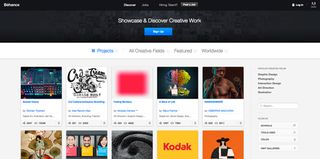How and where to find new design talent
We ask top design firms and agencies how they find and attract tomorrow’s brightest lights.

Discovering and developing talented young creatives is one of the most rewarding aspects of the design industry. But there's little fun to be had sifting through teetering mountains of submitted CVs and portfolios, and professional recruiting agencies can often be more of a hindrance than a help. Besides, a day of interviewing candidates could be better spent on that promising speculative pitch work, right?
Wrong. Finding time to identify, secure and harness new talent is one of the best investments a studio can make. Creative directors who can spot and nurture new talent are very much in demand, while successful agencies often devote entire departments to recruiting, and offer highly competitive internships and placements to scoop up the cream of the graduate crop.
At a very fundamental level, a studio's success rests upon the talent of its employees. That goes for all aspects of commercial business, of course. But when it comes to the creative industries it's even more vital: the quality of a studio's work is defined by the talent of the staff who produce it.
There's no limit to how far we'll go to get the right person
Fresh talent is the key source of competitive advantage as a creative agency. New graduate entrants come brimming with verve and enthusiasm, which can have a positive impact on performance and productivity. Graduates also bring new skills and a fresh perspective.
Whether you're a two-man studio looking to expand or a medium-sized agency with a distinct placement and recruitment programme, recognising where to spot talented individuals, how to hire and keep them, and how to develop them into creatives who drive your business forward is a vital undertaking.
So where do you start? Being capable of spotting a standout portfolio in a teetering pile isn’t considered a recruiting skill as such. That's because solid creative recruiting begins with knowing where to come by the best new talent and which candidates to invite for interview.
"You have to find people as you go," says manvsmachine co-founder and creative director, Mike Alderson. "[For us] there's no point advertising for jobs, because the people looking for jobs aren't the people we want. So it's more about discovering people via their online presence or blogs, or seeing what they're up to. We've got visas for various people over the years – there's no limit to how far we'll go to get the right person."
Get the Creative Bloq Newsletter
Daily design news, reviews, how-tos and more, as picked by the editors.
Sites of inspiration
Svein Haakon Lia, creative director and founding partner of Norwegian agency Bleed, agrees: "Usually we look at design inspiration and portfolio pages on websites like Behance, Site inspire and Cargo Collective before inviting people in. It also depends a lot on the experience level we’re looking for," he adds.
"Sometimes the exhibitions of different design schools are a great source. We also have a steady flow of portfolios being sent to us, and we keep the best for later reference."
Graduate shows are an obvious place to spot fresh talent, and dozens of these events are hosted by the world's best universities and colleges, as well as some independent bodies. Global showcases like the D&AD's New Blood series help identify, support and promote tomorrow’s creative superstars, while organisations like YCN offer an international platform for new talent to show their wares.

New Designers, meanwhile, is a permanent fixture in the UK creative calendar and takes place over a two-week period in london, where it exhibits over 3,000 graduates plucked from the UK's leading colleges and universities. elsewhere, global events like ADC's excellent portfolio Nights, which have been likened to creative speed-dating sessions between new designers and industry figures, provide further opportunities to seek out and discover the next generation.
The creative recruitment sector has changed fundamentally over the last decade: recruitment specialists are no longer seen as harbingers of bad Cvs and unsuitable portfolios. many agencies and smaller studios dismiss recruitment firms outright, but the good ones are worth their fee.
Why recruit recruiters?
Hiring the wrong staff drains productivity. It's stressful and often a huge waste of money. Using a recruitment agency averages 15 per cent commission of the agreed salary, but crucially your interests are protected – a typical contract states that no fee will be due until the candidate passes their probation. Yet many studios remain averse to professional recruiters.
"We never use [recruitment firms]," says Bleed's Haakon lia. "A lot of companies have contacted us over the years, but I've never seen them present any relevant candidates. I think there's a definite clash between our creative and artistic mission, and their intentions."
I think there's a definite clash between our creative and artistic mission, and their intentions
Recruitment agents have their own agenda, which is of course to place their candidate, but most want to do that in a way that also benefits the client. At the same time, if you're on the lookout for a specific type of new talent, developing a relationship with a range of recruiters and spelling out precisely what type of candidates are of interest to you means you're covering all bases and ensures only the most relevant creatives will be presented.
"The key to getting the best from recruiters is being absolutely clear-cut in describing what the role is, the skills and experience you require and the budget you have to spend in filling it," says Dianne Brak, Ceo of CreativeFuse, a global recruitment firm that has placed talent in leading agencies like landor, mcCann Worldwide, JWT and loewy.
"It's often the case that smaller agencies want two or three skill sets in one role. There's a Swiss-Army knife approach to role descriptions. A good recruiter will help focus not only on who to employ, but also on what that role is within the existing company structure."
Wheat from chaff
Advertising for new graduates through your site and on social media will bring a slew of applications – that's almost guaranteed. However, being able to spot the talent in the crowd requires being disciplined and highly focused. It's normally pretty clear who has creative talent from a portfolio, but that doesn’t tell the whole story of a potential hire, according to Oli Bussell at The Partners london.
Being able to use illustrator and photoshop effectively isn’t necessarily the skillset to look out for. Bussell is tasked with recruiting new designers to the agency, and believes a face-to-face interview is still the best way to unearth new talent.
"A portfolio tends to separate the more ideas-focused graduates from the technical wizards" he says. "Beyond this, we always interview potential placements and get them to talk through their work with us. This always gives us a better indication of what they're like as a person – it allows us to give feedback and often reveals the hidden gems that a PDF couldn't quite do justice.
"We always look for ideas-focused work. I would much rather see a really strong concept that gets me excited but isn't incredibly visualised than a stunning visual that has no real thought behind it. A base level of software skill is essential, but 90 per cent of Adobe tricks and tips are learned on the job. Great conceptual thinking on the other hand is a much harder skill to simply 'pick up'."

Sell the dream
Interviews can be stressful on both sides of the table, but turn it into a rewarding process and the whole studio will benefit. Looking at a portfolio only teaches you about an applicant's skills in execution and finishing, but a discussion about it provides greater insight and helps gauge their passion for design, and how they can fit into your studio.
And while asking the right questions is helpful, try deliberately leaving out important points so the interviewee can bring them up – it's a great way to gauge whether you're on the same wavelength. Be prepared to jump in rather than allow important points to go unaddressed, though.
Of course, interviews are a two-way process and it's not unheard of for highly exposed graduates to receive multiple job offers. Securing the cream of the crop isn't as crass as a bidding war, though. Being seen as a solid place to work and grow while gaining experience on exciting projects is a hard offer to turn down – so sell yourself.
Freedom is the best way to keep people
"We want people who think Bleed is a good place for [graduates] to evolve and grow," says creative director Haakon lia. "We try to communicate as well as possible what makes working at Bleed unique. We want designers who honestly see that and want to work for us."
Be sure to offer new graduates input into their career development as well, to help them realise their full potential. Having a clear personal development plan that aligns with their career aspirations will keep them in your employment for longer; and if they're talented, you want them to develop on your dime.
"You need to tie them in with incentives and reward them well," says CreativeFuse's Brak. "[But also] try to build future paths for them so they don't only see what's immediate. Then offer the next step at the right time."
Even if your new recruit does eventually fly the nest, don't take it as a criticism. Seeing new graduates develop into creative heavyweights – while contributing to your studio's bottom line – reinforces your own studio's reputation. What's more, it’s hugely rewarding:
"We do our best to give people an opportunity to grow and follow their own direction. Freedom is the best way to keep people," adds Haakon lia. "But of course we can't keep everybody, and when that happens the people who leave get really good positions and opportunities at other places. It's so rewarding to see that springboard and we take that as a huge compliment."
Words: Tom Dennis Illustration: Bratislav Milenkovic
This article originally appeared in Computer Arts issue 230.

Thank you for reading 5 articles this month* Join now for unlimited access
Enjoy your first month for just £1 / $1 / €1
*Read 5 free articles per month without a subscription

Join now for unlimited access
Try first month for just £1 / $1 / €1
The Creative Bloq team is made up of a group of design fans, and has changed and evolved since Creative Bloq began back in 2012. The current website team consists of eight full-time members of staff: Editor Georgia Coggan, Deputy Editor Rosie Hilder, Ecommerce Editor Beren Neale, Senior News Editor Daniel Piper, Editor, Digital Art and 3D Ian Dean, Tech Reviews Editor Erlingur Einarsson, Ecommerce Writer Beth Nicholls and Staff Writer Natalie Fear, as well as a roster of freelancers from around the world. The ImagineFX magazine team also pitch in, ensuring that content from leading digital art publication ImagineFX is represented on Creative Bloq.
